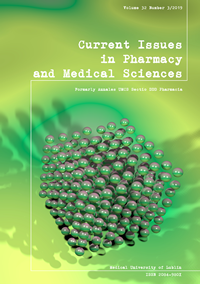Hypolipidemic, hepatoprotective, nephroprotective and anti-lipid peroxidation properties of a methanol extract of Paullinia pinnata root-bark, in alloxan-induced hyperglycemic rats
DOI:
https://doi.org/10.2478/cipms-2019-0023Keywords:
antioxidant, Paullinia pinnata, hepatoprotective, nephroprotective, lipid profileAbstract
This study evaluated the hypolipidemic, hepatoprotective, nephroprotective and anti-lipid peroxidation properties of a methanol extract of Paullinia pinnata root-bark, in alloxan-induced hyperglycemic rats. The extract of P. pinnata root-bark was prepared using a cold maceration method with 80% methanol and concentrated at 40°C in hot air oven. The extract was administered once daily per os at 50, 100 and 200 mg/kg for 21 consecutive days. Distilled water (5 mL/kg) and glibenclamide (2 mg/kg) were used as the vehicle and reference standard, respectively. The serum lipid profile, markers of liver and kidney functions, antioxidant status (malondialdehyde level, superoxide dismutase and catalase activities), histopathological changes in liver and kidney were examined 24h after the last treatment on day 21. The extract reduced serum lipid profile, markers of liver and kidney functions of treated rats relative to vehicle-treated rats. The superoxide dismutase and catalase activities of the extract treated rats were also elevated relative to the vehicle-treated rats. The extract reversed liver and kidney injuries induced by alloxan in the treated rats. This study provides some basic information which suggest that P. pinnata could be effective in managing diabetic complications.
References
1. Ajiboye BO, Oloyede HOB, Salawu MO. Antihyperglycemic and antidyslipidemic activity of Musa paradisiaca – based diet in alloxan-induced diabetic rats. Food Sci Nutr. 2018;6:137-45. https://doi.org/10.1002/fsn3.538
2. Chen L, Magliano DJ, Zimmet PZ. The worldwide epidemiology of type 2 diabetes mellitus – present and future perspectives. Nat Rev Endocrinol. 2012;8:228-36. https://doi.org/10.1038/nrendo.2011.183
3. Matsuda M, Shimomura I. Increased oxidative stress in obesity: implications for metabolic syndrome, diabetes, hypertension, dyslipidemia, atherosclerosis, and cancer. Obes Res Clin Pract. 2013;7(5):e330-e341. http://dx.doi.org/10.1016/j.orcp.2013.05.004
4. Tangvarasittichai S. Oxidative stress, insulin resistance, dyslipidemia and type 2 diabetes mellitus. World J Diabetes. 2015;6(3):456-80. https://doi.org/10.4239/wjd.v6.i3.456
5. Nweze CC, Ubhenin AE, Lay TU, Muhammad AU. Hypoglycemic, hepatoprotective and hypolipidemic effects of Pleurotus ostreatus in alloxan-induced hyperglycemic rats. Trop J Nat Prod Res. 2017;1:163-7. https://doi.org//10.26538/tjnpr/v1i4.5
6. Zimmet PZ, McCarty DJ, DeCourten MP. The global epidemic of non-insulin-dependent diabetes mellitus and the metabolic syndrome. J Diabet Comp. 1997;11:60-8. https://doi.org/10.1016/S1056-8727(96)00090-6
7. Murugan P, Pari L. Antioxidant effect of tetrahydrocurcumin in streptozotocin-nicotinamide induced diabetic rats. Life Sci. 2006;79:1720-8. https://doi.org/10.1016/j.lfs.2006.06.001
8. Kumar R, Arora V, Ram V, Bhandari A, Vyas P. Hypoglycemic and hypolipidemic effect of Allopolyherbal formulations in streptozotocin induced diabetes mellitus in rats. Int J Diabetes Mellit. 2015;3:45-50. https://doi.org/10.1016/j.ijdm.2011.01.005
9. Okwudili OS, Chimaobi NG, Ikechukwu EM, Ndukaku OY. Antidiabetic and in vitro antioxidant effects of hydromethanol extract of Paullinia pinnata root bark in alloxan-induced diabetic rat. J Complement Integr Med. 2017;15(2). https://doi.org/10.1515/jcim-2015-0017
10. Adinortey MB, Sarfo JK, Adukpo GE, Dzotsi E, Kusi S, Ahmed MA, Abdul-Gafaru O. Acute and sub-acute oral toxicity assessment of hydro-alcoholic root extract of Paullinia pinnata on haematological and biochemical parameters. Biol Med. 2012;4(3):121-5. BMID: AR96-BM12
11. Lunga PK, de Dieu Tamokou J, Fodouop SP, Kuiate JR, Tchoumboue J, Gatsing D. Antityphoid and radical scavenging properties of the methanol extracts and compounds from the aerial part of Paullinia pinnata. Springerplus. 2014;3:302. https://doi.org/10.1186/2193 -1801-3-302.
12. Annan K, Houghton PJ. Two novel lupane triterpenoids from Paullinia pinnata L. with fibroblast stimulatory activity. J Pharm Pharmacol. 2010;62:663-8. https://doi.org/10.1211/jpp.62.05.0016
13. Lunga PK, Qin XJ, Yang XW, Kuiate JR, Du ZZ, Gatsing D. A new antimicrobial and radical-scavenging glycoside from Paullinia pinnata var. cameroonensis. Nat Prod Res. 2015;29:1688-94. https://doi.org/10.1080/14786419.2014.996756
14. Abourashed EA, Toyang NJ, Choinski J, Khan IA: Two new flavone glycosides from Paullinia pinnata. J Nat Prod. 1999;62:1179-81. https://doi.org/10.1021/np990063z
15. National Research Council. Guide for the care and use of laboratory animals. National Academies Press;2010. http://www.nap.edu/catalog/12910.html
16. Friedewald WT, Levy RI, Fredrickson DS. Estimation of the concentration of low-density lipoprotein cholesterol in plasma, without use of the preparative ultracentrifuge. Clin Chem. 1972;18: 499-502.
17. Draper HH, Hadley M. Malondialdehyde determination as index of lipid Peroxidation. Methods Enzymol. 1990;186:421-31.
18. Aebi HE. Catalase. In: Methods of enzymatic analysis. edited by HU Bergmeyer. Deerfield Beach: Verlag Chemie;1983:273-86.
19. Xin Z, Waterman DF, Hemken RW, Harmon RJ. Effects of copper status on neutrophil function, superoxide dismutase, and copper distribution in steers. J Dairy Sci. 1991;74:3078-85. https://doi.org/10.3168/jds.S0022-0302(91)78493-2
20. Donkor K, Okine LNK, Abotsi WKM, Woode E. Acute and sub-chronic toxicity studies of aqueous extract of root bark of Cassia sieberiana D.C. in rodents. J Appl Pharm Sci. 2014;4:084-9. https://doi.org/10.7324/JAPS.2014.40415
21. Evans WC. Trease and Evans Pharmacognosy (16th edition). Edinburgh: WB Saunders Elsevier; 2009: 53-61.
22. Jimoh FO, Sofidiya MO, Afolayan AJ. Antioxidant properties of the methanol extracts from the leaves of Paullinia pinnata. J Med Food. 2007;10:707-11. https://doi.org/10.1089/jmf.2006.253
23. Serreli G, Incani A, Atzeri A, Angioni A, Campus M, Cauli E, et al. Antioxidant effect of natural table olives phenolic extract against oxidative stress and membrane damage in enterocyte‐like cells. J Food Sci. 2017;82:380-5. https://doi.org/10.1111 /1750-3841.13613
24. Asgary S, Sahebkar A, Afshani MR, Keshvari M, Haghjooyjavanmard S, Rafieian‐Kopaei M. Clinical evaluation of blood pressure lowering, endothelial function improving, hypolipidemic and anti‐inflammatory effects of pomegranate juice in hypertensive subjects. Phytother Res. 2014;28(2):193-9. https://doi.org/10.1002/ptr.4977
25. Sharmin ZR, Akter MT, Rahman R, Hoque M, Khan I, Mosaddek AS. Comparative study of hypolipidemic effects of Momordica Charantia (karela) with atorvastatin in fat fed rats. Journal of Human Health Research. 2017;1:11. https://doi.org/10.14302/issn.2576-9383.jhhr-17-1816
26. Ning N, He K, Wang Y, Zou Z, Wu H, Li X, Ye X. Hypolipidemic effect and mechanism of palmatine from Coptis chinensis in hamsters fed high‐fat diet. Phytother Res. 2015;29:668-73. https://doi.org/10.1002/ptr.5295
27. Szkudelski T. The mechanism of alloxan and streptozotocin action in B cells of the rat pancreas. Physiol Res. 2001;50:537-46.
Downloads
Published
Issue
Section
License
Copyright (c) 2019 Autors

This work is licensed under a Creative Commons Attribution-NonCommercial-NoDerivatives 3.0 Unported License.


